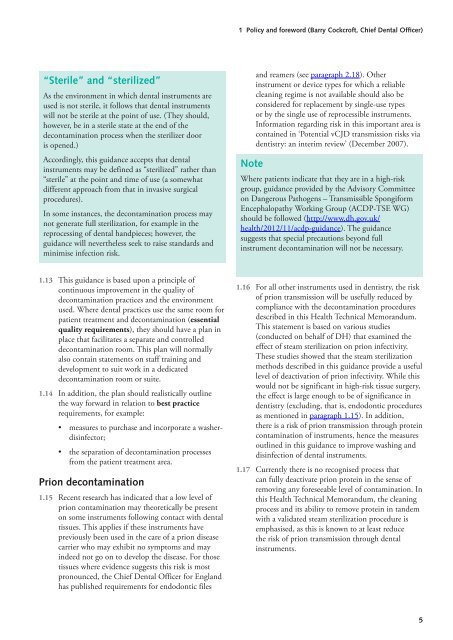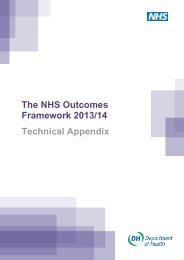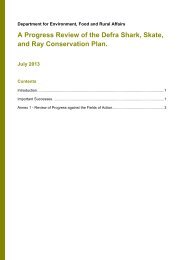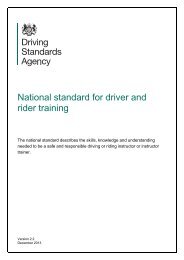Decontamination in primary care dental practices - Gov.uk
Decontamination in primary care dental practices - Gov.uk
Decontamination in primary care dental practices - Gov.uk
You also want an ePaper? Increase the reach of your titles
YUMPU automatically turns print PDFs into web optimized ePapers that Google loves.
1 Policy and foreword (Barry Cockcroft, Chief Dental Officer)“Sterile” and “sterilized”As the environment <strong>in</strong> which <strong>dental</strong> <strong>in</strong>struments areused is not sterile, it follows that <strong>dental</strong> <strong>in</strong>strumentswill not be sterile at the po<strong>in</strong>t of use. (They should,however, be <strong>in</strong> a sterile state at the end of thedecontam<strong>in</strong>ation process when the sterilizer dooris opened.)Accord<strong>in</strong>gly, this guidance accepts that <strong>dental</strong><strong>in</strong>struments may be def<strong>in</strong>ed as “sterilized” rather than“sterile” at the po<strong>in</strong>t and time of use (a somewhatdifferent approach from that <strong>in</strong> <strong>in</strong>vasive surgicalprocedures).In some <strong>in</strong>stances, the decontam<strong>in</strong>ation process maynot generate full sterilization, for example <strong>in</strong> thereprocess<strong>in</strong>g of <strong>dental</strong> handpieces; however, theguidance will nevertheless seek to raise standards andm<strong>in</strong>imise <strong>in</strong>fection risk.Noteand reamers (see paragraph 2.18). Other<strong>in</strong>strument or device types for which a reliableclean<strong>in</strong>g regime is not available should also beconsidered for replacement by s<strong>in</strong>gle-use typesor by the s<strong>in</strong>gle use of reprocessible <strong>in</strong>struments.Information regard<strong>in</strong>g risk <strong>in</strong> this important area isconta<strong>in</strong>ed <strong>in</strong> ‘Potential vCJD transmission risks viadentistry: an <strong>in</strong>terim review’ (December 2007).Where patients <strong>in</strong>dicate that they are <strong>in</strong> a high-riskgroup, guidance provided by the Advisory Committeeon Dangerous Pathogens – Transmissible SpongiformEncephalopathy Work<strong>in</strong>g Group (ACDP-TSE WG)should be followed (http://www.dh.gov.<strong>uk</strong>/health/2012/11/acdp-guidance). The guidancesuggests that special precautions beyond full<strong>in</strong>strument decontam<strong>in</strong>ation will not be necessary.1.13 This guidance is based upon a pr<strong>in</strong>ciple ofcont<strong>in</strong>uous improvement <strong>in</strong> the quality ofdecontam<strong>in</strong>ation <strong>practices</strong> and the environmentused. Where <strong>dental</strong> <strong>practices</strong> use the same room forpatient treatment and decontam<strong>in</strong>ation (essentialquality requirements), they should have a plan <strong>in</strong>place that facilitates a separate and controlleddecontam<strong>in</strong>ation room. This plan will normallyalso conta<strong>in</strong> statements on staff tra<strong>in</strong><strong>in</strong>g anddevelopment to suit work <strong>in</strong> a dedicateddecontam<strong>in</strong>ation room or suite.1.14 In addition, the plan should realistically outl<strong>in</strong>ethe way forward <strong>in</strong> relation to best practicerequirements, for example:• measures to purchase and <strong>in</strong>corporate a washerdis<strong>in</strong>fector;• the separation of decontam<strong>in</strong>ation processesfrom the patient treatment area.Prion decontam<strong>in</strong>ation1.15 Recent research has <strong>in</strong>dicated that a low level ofprion contam<strong>in</strong>ation may theoretically be presenton some <strong>in</strong>struments follow<strong>in</strong>g contact with <strong>dental</strong>tissues. This applies if these <strong>in</strong>struments havepreviously been used <strong>in</strong> the <strong>care</strong> of a prion diseasecarrier who may exhibit no symptoms and may<strong>in</strong>deed not go on to develop the disease. For thosetissues where evidence suggests this risk is mostpronounced, the Chief Dental Officer for Englandhas published requirements for endodontic files1.16 For all other <strong>in</strong>struments used <strong>in</strong> dentistry, the riskof prion transmission will be usefully reduced bycompliance with the decontam<strong>in</strong>ation proceduresdescribed <strong>in</strong> this Health Technical Memorandum.This statement is based on various studies(conducted on behalf of DH) that exam<strong>in</strong>ed theeffect of steam sterilization on prion <strong>in</strong>fectivity.These studies showed that the steam sterilizationmethods described <strong>in</strong> this guidance provide a usefullevel of deactivation of prion <strong>in</strong>fectivity. While thiswould not be significant <strong>in</strong> high-risk tissue surgery,the effect is large enough to be of significance <strong>in</strong>dentistry (exclud<strong>in</strong>g, that is, endodontic proceduresas mentioned <strong>in</strong> paragraph 1.15). In addition,there is a risk of prion transmission through prote<strong>in</strong>contam<strong>in</strong>ation of <strong>in</strong>struments, hence the measuresoutl<strong>in</strong>ed <strong>in</strong> this guidance to improve wash<strong>in</strong>g anddis<strong>in</strong>fection of <strong>dental</strong> <strong>in</strong>struments.1.17 Currently there is no recognised process thatcan fully deactivate prion prote<strong>in</strong> <strong>in</strong> the sense ofremov<strong>in</strong>g any foreseeable level of contam<strong>in</strong>ation. Inthis Health Technical Memorandum, the clean<strong>in</strong>gprocess and its ability to remove prote<strong>in</strong> <strong>in</strong> tandemwith a validated steam sterilization procedure isemphasised, as this is known to at least reducethe risk of prion transmission through <strong>dental</strong><strong>in</strong>struments.5
















